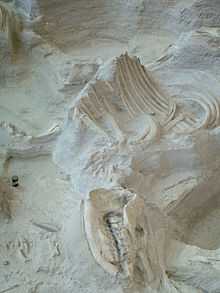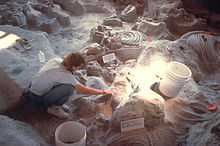Ashfall Fossil Beds
| Ashfall Fossil Beds State Historical Park | |
| Nebraska State Historical Park | |
 Hills surrounding the fossil beds | |
| Country | |
|---|---|
| State | |
| County | Antelope |
| Location | Royal |
| - elevation | 1,720 ft (524 m) [1] |
| - coordinates | 42°25′30″N 98°09′31″W / 42.42500°N 98.15861°WCoordinates: 42°25′30″N 98°09′31″W / 42.42500°N 98.15861°W |
| Area | 360 acres (146 ha) |
| Founded | 1991 |
| Management | Nebraska Game and Parks Commission |
| style=""color: #cde5b2"" | IUCN category | III |
|
Location of Ashfall State Historical Park in Nebraska
| |
| Website: Ashfall Fossil Beds State Historical Park | |
| Designated | 2006 |
The Ashfall Fossil Beds of Antelope County in northeastern Nebraska are among the rare preservation sites called lagerstätten, which preserve ecological "snapshots" from a moment in time, due to extraordinary local conditions that have preserved a range of fossilized organisms undisturbed. Ash from a Yellowstone hotspot eruption 10-12 million years ago created this ashbed.
The Ashfall Fossil Beds are especially famous for fossils of mammals from the middle Miocene geologic epoch. The Ashfall Fossil Beds are stratigraphically part of the Serravallian-age[2] Ogallala Group.
The site is now protected as Ashfall Fossil Beds State Historical Park, which includes a visitor center with interpretive displays and working fossil preparation laboratory, and a building over an ongoing excavation site that features native American rhinos and ancestral horses.
Bruneau-Jarbidge event
The Ashfall deposit preserves the fossilized remains of ancient animals that perished in a dense volcanic ash fall which occurred during the late Miocene, approximately 12 million years ago; the animals had come to a waterhole seeking relief. The fall of ash drifted downwind from the Bruneau-Jarbidge supervolcano eruption (in present-day Idaho), nearly 1,000 miles (1,600 km) west of the Ashfall site. A large number of very well preserved fossil rhinos, small three-toed and one-toed horses, camels, and birds have been excavated. Many animals were preserved with their bones articulated; one rhino still bears her unborn fetus, while others retain the contents of their last meal.
The bones of the animals show features that indicate that the animals died of lung failure induced by inhaling volcanic ash. The smaller animals with smaller lung capacity were the first to die, and the larger animals were the last. Bite-marks on some bones show that local predators (the carnivorous bone-crunching dog Aelurodon) scavenged some of the carcasses, but no predator remains have yet surfaced. There are also abundant clues to the region's ecology, indicating a savanna of grassland interspersed with trees that luxuriated in a warmer, milder climate than today's.
The rapidly accumulating ash, windblown into deep drifts at low places like the waterhole site, remained moderately soft. The ash preserved the animals in three dimensions; not even the delicate bones of birds or the carapaces of turtles were crushed. Above the layer of ash, a stratum of more erosion-resistant sandstone has acted as "caprock" to preserve the strata beneath.


Preservation
The first hint of the site's richness was the skull of a juvenile rhinoceros noticed in 1971 eroding out of a gully at the edge of a cornfield. The Ashfall site became Ashfall Fossil Beds State Historical Park in 1991. Newly uncovered fossils are being left exactly as they are found: specially constructed walkways afford visitors an unobstructed close-up view of paleontologists at work during the summer field season. The site was declared a National Natural Landmark on May 9, 2006[3]
Species
The remains of Teleoceras are so numerous and concentrated that the main section of Ashfall is called the "Rhino Barn". Other fossils at the "Rhino Barn" include the remains of horses and camels. Taxa discovered in the Ashfall deposits include:
- five genera of horse: Cormohipparion, Protohippus, Pseudhipparion, Neohipparion and Pliohippus
- three genera of camelids: Procamelus, Aepycamelus and Protolabis
- three genera of canids: Leptocyon, Cynarctus and Aelurodon
- one genus of rhinoceros: Teleoceras
- one genus of saber-toothed deer: Longirostromeryx
- three bird species: crowned crane (Balearica exigua), rail and secretary bird (Apatosagittarus)
- two species of turtle: Hesperotestudo and pond turtle
See also
- Gray Fossil Site
- List of fossil sites (with link directory)
- Pipe Creek Sinkhole
References
- ↑ "Ashfall Fossil Beds State Historical Park". Geographic Names Information System. United States Geological Survey. 2000-06-13. Retrieved 2011-04-30.
- ↑ Often called Clarendonian in North American contexts.
- ↑ "Acting Interior Secretary Scarlett Designates Ashfall Fossil Beds A National Natural Landmark". United States Department of the Interior. 2006-05-09. Archived from the original on 2006-06-15. Retrieved 2006-06-11.
External links
| Wikimedia Commons has media related to Ashfall Fossil Beds. |
- Ashfall Fossil Beds - University of Nebraska State Museum
- Mike Voorhies, "Ashfall: Life and Death at a Nebraska Waterhole Ten Million Years Ago" from University of Nebraska State Museum Notes Number 81 (February 1992)
- Nebraska Game and Parks Commission - Ashfall Fossil Beds State Historical Park
- NebraskaStudies.org - Ashfall
- Paleobiology Database: Ashfall Fossil Beds: Clarendonian - Miocene, Nebraska
- Skeleton map of the Ashfall Fossil Beds
| ||||||||||||||||||||||||||||||||||||||||||||||||||||||||||